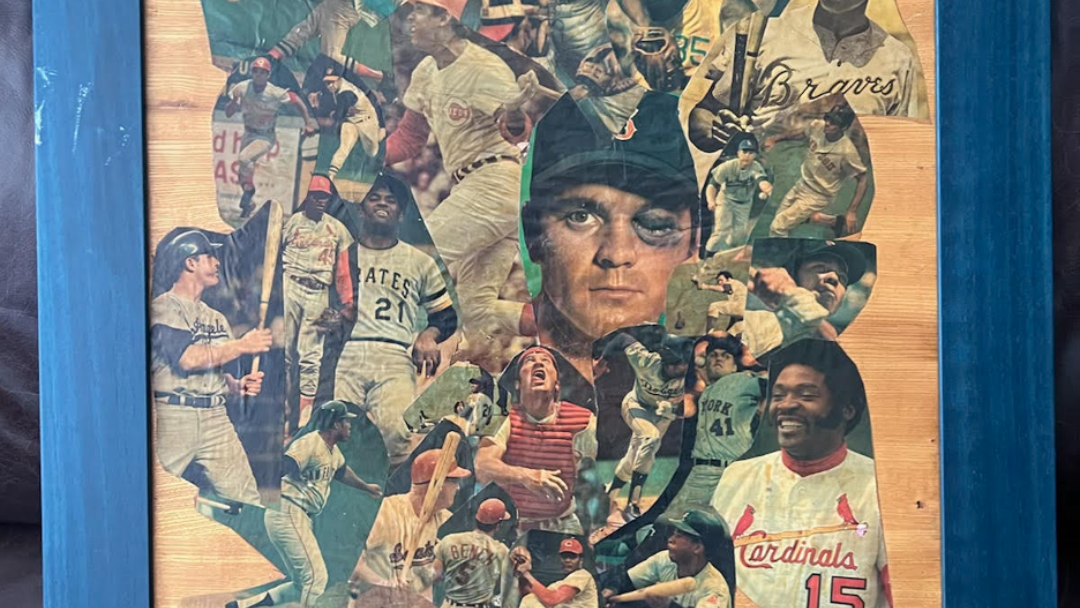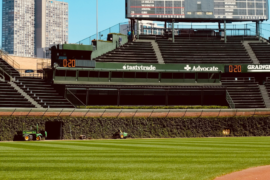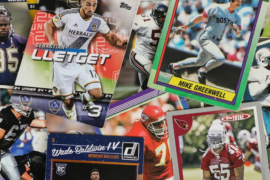THE OTHER DAY MY SIX-YEAR OLD GRANDSON PHIN ASKED ME to sit next to him so he could show me his binder of trading cards. He turned the pages, pointing out his favorites. Some he likes because of the action shown, bat just connecting with ball, the hitter laser-focused; a sliding catch in the outfield. Some appeal to him on artistic quality, the color scheme or snazzy 3-D background. I like it best, though, when he lingers over a favorite player, “Freddie Freeman,” he’ll say with whispered respect, as if the name is all that’s needed. Or “Willson,” for Willson Contreras, who he got to see play at Wrigley field with his mom and grandpa. For weeks after that his games of catch included assuming the catcher position in an uncanny impersonation of Contreras, right leg extended in the crouch, glove held in horizontal position. He would walk around home plate with his facemask up, looking as if he was thinking of what pitch to call next.
His favorite is Freeman, whose playoff and World Series heroics with the Braves in 2021 were the first entry in Phin’s awareness of superstardom. Touching the plastic jacket protecting Freddie, now in a Dodgers uniform he says “He looks determined.” “Yes,” I respond, “he’s serious for sure.” This is all he seems to need. Affirmation.
I grew up in the 1970’s with three baseball-crazed brothers who collected trading cards too, though “collected” might imply the wrong impression of holding onto something protectively. Rather, what I remember is baseball cards clipped onto bicycle tire spokes with clothes pins, Maury Wills and Nolan Ryan spinning dizzyingly through space, their sincere smiles never changing; 9 cards arranged by position on a field in proportion to their size, a brother with pencil for a bat and marble for ball preparing to represent the next hitter; cards held with Scotch tape to dressers or headboards or walls. Their cards were bent and wrinkled, bound together by category with rubber-bands and stored in shoe boxes beneath their beds. Boxes and boxes of them.
Of top value at our house were members of the LA Dodgers – this was the heyday of Garvey, Lopes, Cey and Russell. Like Phin, my brothers were masters of mimicry. I could watch as they played their games of tennis ball baseball in the driveway or whiffle-ball in the backyard and determine where they were in the lineup by their batting stances. Bat straight up and still, chin thrust forward, left forearm flexed and prominent – “the Garv,” Steve Garvey. Bat twitching in circular motion, shoulders flexed, pigeon-toed stance, “The Penguin,” Ron Cey. For Reggie Smith they switched to the left-side of the plate and held the bat high. Vic Davilillo (one of my favorites if only for the way Vin Scully said his name, the “Vic” hard and quick, like an eighth note, leading into DA-VA-LEE-O, accent on the “LEE” and celebratory “O”) stood out for the exaggerated lift of his lead leg to time the pitches. What I hadn’t realized back then, that watching Phin makes clear to me, is the extent to which they imagined themselves into the player, so that even between pitches they stayed in character.
Sports is the language of Phin’s culture. In other times or places, he might be practicing a silent stalk or perfecting his aim with a projectile. Here, in a suburb of Chicago in the 2020’s, the corollaries are stealing a base, pegging a runner at home. At six, when he practices pitching, he motions to check the runner at first even though leadoffs are not allowed in his league. Batting, he adjusts his stance with a forward thrust of the hips in imitation of Anthony Rizzo, whose #44 Cubs jersey was the first piece of sports paraphernalia he acquired. Last year he told me he already knew how to swing a golf club from watching a friend’s dad and then he executed a beautiful swing “like this,” he said and then, on the follow-through: “And then you look like you know you did really good.” Clearly, he has been observing carefully.
All of that is wrapped up in his – and now I realize, my brothers’ obsession with baseball cards. Somehow, these 2-dimensional static representations of players are a window into what it means to be a successful professional athlete and maybe, just maybe, if they can imitate them well enough, they can get there too. Actually, knowing Phin’s six-year-old mindset, I know it’s not “maybe” at all. He’s counting on it, no doubt.
What do you do with all those cards when childhood has passed? There’s a dad in Phin’s neighborhood who inherited a collection from his dad. He likes to engage people in conversation and figure out their favorite teams and players. If he has a match, he’ll gift it. Shortly after meeting Phin’s dad, Griffin, Marty gave him a 1995 John Elway football card. Both Griffin and Marty were thrilled.
My youngest brother, Russ, is the keeper of my brothers’ collection, having been the one to continue the hobby into high school. He has some great cards – Hank Aaron, Willie Mays, Nolan Ryan, Roberto Clemente (I feel I can still see each of these in my mind’s eye.) There are collections of rookie cards, All-Star sets, vintage cards for stars in the past. There were players with classic nicknames: “Hammerin’ Hank” Aaron, Stan “The Man” Musial, Jimmy “The Toy Cannon” Wynn. And some whose names were just plain fun to say: Catfish Hunter, Harmon Killebrew, Boog Powell, Tony Conigliaro. (Conigliaro looms large in my memory as he did in the collage my brothers made of photos from Sports Illustrated, his bruised and swollen face drawing the viewers eye by position and size and fascination. They pasted the photos on a piece of wood and decoupaged over it. It hangs in Russ’s office today. See pictured.) Of course, because they were so well-used, well-loved, the cards are not in the mint condition prized by collectors and so are worth very little to anyone except for us.
And so I watch Phin page through his nascent collection and I know now there is something more here than meets the eye. I think about how Russ, who played shortstop through high school and college, moved around the infield much like Bill Russell of those 1970’s Dodgers did, with an economy of motion and restrained demeanor. And about how Phin assumes a Freddie Freeman-esque look of determination in any sport he plays. His careful observation and mimicry of the players depicted on these playing cards, these relics of childhood, contribute in no small way to who he is becoming.
MELISSA KINSEY grew up a Dodgers fan in the 1970’s. Her grandson’s collection of baseball cards took her back to the days of growing up with three baseball-crazed brothers in a house where everyone knew the Dodgers’ starting lineup and could instantly answer the question: who were the first five members of the Baseball Hall of Fame?
Like what you’re reading?
Get new stories, sports musings, or book reviews sent to your inbox. Drop your email below to start >>>
NEW book release
Ghosts Caught on Film by Barrett Bowlin. Order the book of which Dan Chaon says “is a thrilling first collection that marks a beginning for a major talent.”
GET THE BOOK



